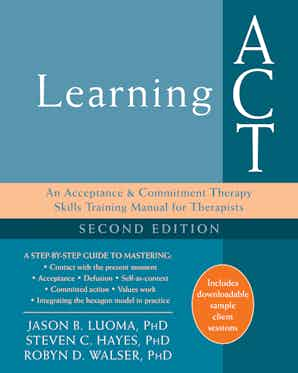By Robyn Walser, PhD, coauthor of Learning ACT, 2nd Edition
When New Harbinger first approached me about writing a second edition of Learning ACT, I felt excitement followed by worry. Some of this worry simply had to do with getting the second edition written, giving up the time needed to make it happen, and being responsible to my co-authors, Jason Luoma and Steven Hayes. Other parts of this worry were due, more specifically, to the nature of what I hoped we could convey in this second edition: that acceptance and commitment therapy’s (ACT’s) essence and effectiveness lies in mastering the therapeutic dance, and is much more than a set of techniques and metaphors.
As an ACT trainer, I have been watching the progression of ACT across time and have more recently noticed an emerging trend that I hope we as a community can shift, returning a bit to our contextual behavioral roots. The trend I have been noticing has seemed a subtle shift in the application of ACT toward techniques and exercises as the therapy, instead of a therapy that uses techniques and exercises. The focus has appeared to be on the number of metaphors and exercises one learns versus understanding the function of behavior and the fluid integration of the six core processes. If there is any truth to what I have been witnessing, then I turn again toward being excited about Learning ACT, Second Edition.
See also: A Look into the Future of Acceptance and Commitment Therapy
In this edition, we worked to not only focus on the individual processes, but also on the flexible integration of each with the other, techniques aside. I am keen to present a small snippet of the book to show our commitment to conveying the individual processes, but also to learning and using the model in a fluid and process oriented fashion:
Learning ballroom dancing begins by repeatedly practicing the basic parts of a dance: spinning, leading, resting lightly on the balls of your feet, the basic steps, keeping a beat. After you have developed some skill with each of these aspects, you learn how to put them together into a coherent pattern. As you improve, you begin to improvise—adding a spin here, a flourish there—until the whole dance is an improvisation, created from these smaller parts.
Eventually, you’re able to respond fluidly and quickly, effortlessly weaving among other dancers on the floor, staying within the skill of your partner, matching the song that is playing…Throughout most of this book, we focus on the individual parts of the therapeutic dance that is ACT, and the times each move might be deployed. Each step and turn needs to be understood on its own, and each practitioner needs to develop a basic fluency in each part of this therapeutic dance. Increasingly, ACT researchers have shown that each of the flexibility processes and components are effective in their own right. However, these individual moves only turn into an artful dance when they are put together.
Learning ACT, Second Edition brings the importance of knowing each process separately, but moving to flexible integration of all six into view. I hope that this book can be part of a new trend, moving the ACT community back to a place where we hold this process-based therapy as an intervention that uses techniques and exercises—back to its functional beginnings—leaving the techniques and exercises as the therapy behind.
More importantly, I hope that all who read Learning ACT, Second Edition find it a valuable book, not on the shelf, but torn, tattered, and well used in the process of learning acceptance and commitment therapy.
 Robyn Walser, PhD, is director of TL Consultation Services, and codirector of the Bay Area Trauma Recovery Center. She works at the National Center for PTSD developing and disseminating innovative ways to translate science into practice, and serves as assistant clinical professor in the department of psychology at the University of California, Berkeley. She is coauthor of Learning ACT, 2nd Edition.
Robyn Walser, PhD, is director of TL Consultation Services, and codirector of the Bay Area Trauma Recovery Center. She works at the National Center for PTSD developing and disseminating innovative ways to translate science into practice, and serves as assistant clinical professor in the department of psychology at the University of California, Berkeley. She is coauthor of Learning ACT, 2nd Edition.


 Why Journaling Is Especially Helpful to Adult Children of Emotionally Immature Parents
Why Journaling Is Especially Helpful to Adult Children of Emotionally Immature Parents